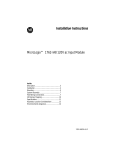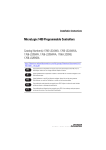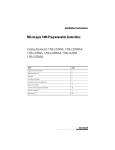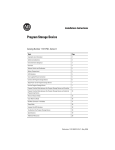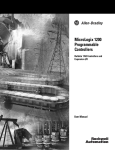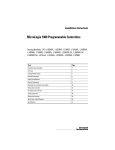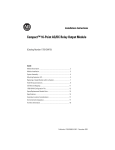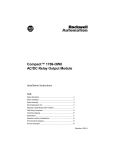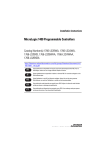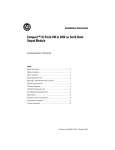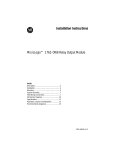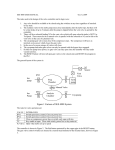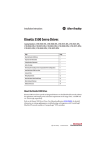Download 1763-IN001 - Rockwell Automation
Transcript
Installation Instructions MicroLogix 1100 Programmable Controllers Catalog Numbers 1763-L16AWA, 1763-L16BWA, 1763-L16BBB, 1763-L16DWD Topic Page Important User Information 4 Additional Resources 5 Overview 6 Controller Description 7 Hazardous Location Considerations 8 Mounting the Controller 10 Connecting 1762 I/O Expansion Modules 16 Wiring the Controller 17 Specifications 23 4 Important User Information Solid state equipment has operational characteristics differing from those of electromechanical equipment. Safety Guidelines for the Application, Installation and Maintenance of Solid State Controls (Publication SGI-1.1 available from your local Rockwell Automation sales office or online at http://literature.rockwellautomation.com) describes some important differences between solid state equipment and hard-wired electromechanical devices. Because of this difference, and also because of the wide variety of uses for solid state equipment, all persons responsible for applying this equipment must satisfy themselves that each intended application of this equipment is acceptable. In no event will Rockwell Automation, Inc. be responsible or liable for indirect or consequential damages resulting from the use or application of this equipment. The examples and diagrams in this manual are included solely for illustrative purposes. Because of the many variables and requirements associated with any particular installation, Rockwell Automation, Inc. cannot assume responsibility or liability for actual use based on the examples and diagrams. No patent liability is assumed by Rockwell Automation, Inc. with respect to use of information, circuits, equipment, or software described in this manual. Reproduction of the contents of this manual, in whole or in part, without written permission of Rockwell Automation, Inc., is prohibited. Throughout this manual, when necessary, we use notes to make you aware of safety considerations. WARNING IMPORTANT ATTENTION Identifies information about practices or circumstances that can cause an explosion in a hazardous environment, which may lead to personal injury or death, property damage, or economic loss. Identifies information that is critical for successful application and understanding of the product. Identifies information about practices or circumstances that can lead to personal injury or death, property damage, or economic loss. Attentions help you identify a hazard, avoid a hazard and recognize the consequences. SHOCK HAZARD Labels may be on or inside the equipment (for example, drive or motor) to alert people that dangerous voltage may be present. BURN HAZARD Labels may be on or inside the equipment (for example, drive or motor) to alert people that surfaces may reach dangerous temperatures. Publication 1763-IN001C-EN-P - June 2015 5 Additional Resources Resource Description MicroLogix 1100 Programmable Controllers User Manual 1763-UM001 A more detailed description of how to install and use your MicroLogix 1100 programmable controller and expansion I/O system. MicroLogix 1100 Instruction Set Reference Manual1763-RM001 A reference manual that contains data and function files, instruction set, and troubleshooting information for MicroLogix 1100. Installation Instructions 1762-INxxx Information on installing and using 1762 expansion I/O modules. Industrial Automation Wiring and Grounding Guidelines 1770-4.1 More information on proper wiring and grounding techniques. If you would like a manual, you can: • download a free electronic version from the internet: http://literature.rockwellautomation.com • purchase a printed manual by contacting your local Allen-Bradley distributor or Rockwell Automation representative Publication 1763-IN001C-EN-P - June 2015 6 Overview MicroLogix 1100 controllers are suitable for use in an industrial environment when installed in accordance with these instructions. Specifically, this equipment is intended for use in clean, dry environments (Pollution degree 2(1)) and with circuits not exceeding Over Voltage Category II(2) (IEC 60664-1).(3) Install your controller using these installation instructions. debris strip ATTENTION Do not remove the protective debris strip until after the controller and all other equipment in the panel near the controller are mounted and wiring is complete. Once wiring is complete, remove protective debris strip. Failure to remove strip before operating can cause overheating. ATTENTION Electrostatic discharge can damage semiconductor devices inside the controller. Do not touch the connector pins or other sensitive areas. (1) Pollution Degree 2 is an environment where, normally, only non-conductive pollution occurs except that occasionally a temporary conductivity caused by condensation shall be expected. (2) Over Voltage Category II is the load level section of the electrical distribution system. At this level transient voltages are controlled and do not exceed the impulse voltage capability of the product’s insulation. (3) Pollution Degree 2 and Over Voltage Category II are International Electrotechnical Commission (IEC) designations. Publication 1763-IN001C-EN-P - June 2015 7 Controller Description 6 5 8 4 12 11 7 ESC OK 3 9 2 10 Item Description 1 Output Terminal Block 2 Battery Connector 3 Bus Connector Interface to Expansion I/O 4 Battery 5 Input Terminal Block 6 LCD Display 7 LCD Display Keypad (ESC, OK, Up, Down, Left, Right) 8 Status LEDs 9 Memory Module Port Cover(1) -or- Memory Module(2) 10 DIN Rail Latches 11 RS-232/485 Communication Port (Channel 0, isolated) 12 Ethernet Port (Channel 1) (1) Shipped with controller. (2) Optional equipment. 1 Publication 1763-IN001C-EN-P - June 2015 8 Catalog Number Description Input Power Digital Inputs Analog Inputs Digital Outputs Comm. Ports 1763-L16AWA 120/240V ac (10) 120V ac (2) voltage input (6) relay 0...10V dc All individually isolated (1) RS-232/485 combo (isolated) (1) Ethernet (2) voltage input (6) relay 24V dc(1) 0 ...10V dc All individually isolated (6) 24V dc (2) voltage input 1763-L16BWA 120/240V ac (6) 24V dc (4) high-speed 1763-L16BBB 24V dc 24V dc(1) 0...10V dc (2) relay (isolated) (1) RS-232/485 combo (2) 24V dc FET (isolated) (2) high-speed (1) Ethernet 24V dc FET (6) 12/24V dc (2) voltage input (6) relay (4) high-speed 0...10V dc All individually isolated (4) high-speed 1763-L16DWD 12/24V dc 12/24V dc(1) (1) (1) RS-232/485 combo (isolated) (1) Ethernet (1) RS-232/485 combo (isolated) (1) Ethernet The 4 high-speed inputs (inputs 0 through 3) can be used for pulse latching or higher speed counting. Refer to Input Specifications on page 25 and the MicroLogix 1100 Instruction Set Reference Manual, publication 1763-RM001, for more information. Hazardous Location Considerations This equipment is suitable for use in Class I, Division 2, Groups A, B, C, D or non-hazardous locations only. The following WARNING statement applies to use in hazardous locations. Publication 1763-IN001C-EN-P - June 2015 9 WARNING EXPLOSION HAZARD • Substitution of components may impair suitability for Class I, Division 2. • Do not replace components or disconnect equipment unless power has been switched off. • Do not connect or disconnect components unless power has been switched off. • This product must be installed in an enclosure. All cables connected to the product must remain in the enclosure or be protected by conduit or other means. • All wiring must comply with N.E.C. article 501-10(b). • The interior of the enclosure must be accessible only by the use of a tool. • For applicable equipment (for example, relay modules), exposure to some chemicals may degrade the sealing properties of the materials used in these devices: – Relays, epoxy It is recommended that you periodically inspect these devices for any degradation of properties and replace the module if degradation is found. Publication 1763-IN001C-EN-P - June 2015 10 Use only the following communication cables in Class I, Division 2 hazardous locations. Environment Classification Communication Cables Class I, Division 2 Hazardous Environment 1761-CBL-AC00 Series C or later 1761-CBL-AM00 Series C or later 1761-CBL-AP00 Series C or later 1761-CBL-PM02 Series C or later 1761-CBL-HM02 Series C or later 1761-CBL-PH02 Series A or later 1761-CBL-AH02 Series A or later 2707-NC9 Series C or later 1763-NC01 Series A or later ATTENTION UNSUPPORTED CONNECTION Do not connect a MicroLogix 1100 controller to another MicroLogix family controller such as MicroLogix 1000, MicroLogix 1200, or MicroLogix 1500 using a 1761-CBL-AM00 (8-pin mini-DIN to 8-pin mini-DIN) cable or equivalent. This type of connection will cause damage to the RS-232/485 communication port (Channel 0) of the MicroLogix 1100 and/or the controller itself. Communication pins used for RS-485 communications are alternately used for 24V power on the other MicroLogix controllers. Mounting the Controller General Considerations Most applications require installation in an industrial enclosure to reduce the effects of electrical interference and environmental exposure. Locate your controller as far as possible from power lines, load lines, and other sources of electrical noise such as hard-contact switches, relays, and ac motor drives. For more information on proper grounding guidelines, see the Industrial Automation Wiring and Grounding Guidelines, publication 1770-4.1. Publication 1763-IN001C-EN-P - June 2015 11 ATTENTION Vertical mounting is not supported due to thermal considerations. ATTENTION Be careful of metal chips when drilling mounting holes for your controller or other equipment within the enclosure or panel. Drilled fragments that fall into the controller could cause damage. Do not drill holes above a mounted controller if the protective debris strips have been removed. Mounting Dimensions C A B 1763-L16AWA, 1763-L16BWA, 1763-L16BBB, 1763-L16DWD Dimension 1763L16AWA A 90 mm (3.5 in.) B 110 mm (4.33 in.) C 87 mm (3.43 in.) L16BWA L16BBB L16DWD Publication 1763-IN001C-EN-P - June 2015 12 Controller Spacing The controller mounts horizontally, with the expansion I/O extending to the right of the controller. Allow 50 mm (2 in.) of space on all but the right side for adequate ventilation, as shown below. Top Side ESC OK Bottom DIN Rail Mounting The maximum extension of the latch is 14 mm (0.55 in.) in the open position. A flat-blade screwdriver is required for removal of the controller. The controller can be mounted to EN50022-35x7.5 or EN50022-35x15 DIN rails. DIN rail mounting dimensions are shown below. B A C Dimension Height A 90 mm (3.5 in.) B 27.5 mm (1.08 in.) C 27.5 mm (1.08 in.) Publication 1763-IN001C-EN-P - June 2015 13 Follow these steps to install your controller on the DIN rail. 1. Mount your DIN rail. (Make sure that the placement of the controller on the DIN rail meets the recommended spacing requirements. See Controller Spacing on page 12. Refer to the mounting template inside the back cover of this document.) 2. If it is open, close the DIN latch. 3. Hook the top slot over the DIN rail. 4. While pressing the controller down against the top of the rail, snap the bottom of the controller into position. 5. Leave the protective debris strip attached until you are finished wiring the controller and any other devices. Follow these steps to remove your controller from the DIN rail. 1. Place a flat-blade screwdriver in the DIN rail latch at the bottom of the controller. 2. Holding the controller, pry downward on the latch until the latch locks in the open position. 3. Repeat steps 1 and 2 for the second DIN rail latch. 4. Unhook the top of the DIN rail slot from the rail. ESC open OK closed Publication 1763-IN001C-EN-P - June 2015 14 Panel Mounting Mount to panel using #8 or M4 screws. Follow these steps to install your controller using mounting screws. 1. Remove the mounting template from inside the back cover of this document. 2. Secure the template to the mounting surface. (Make sure your controller is spaced properly. See Controller Spacing on page 12.) 3. Drill holes through the template. 4. Remove the mounting template. 5. Mount the controller. Mounting Template 6. Leave the protective debris strip in place until you are finished wiring the controller and any other devices Using the Battery The MicroLogix 1100 controller is equipped with a replaceable battery. The Battery Low indicator on the LCD display of the controller shows the status of the replaceable battery. When the battery is low, the indicator is set (displayed as a solid rectangle). This means that either the battery wire connector is disconnected, or the battery may fail within 2 days if it is connected. IMPORTANT The MicroLogix 1100 controller ships with the battery wire connector connected. Ensure that the battery wire connector is inserted into the connector port if your application needs battery power. For example, when using a real-time clock (RTC), or to store the program in the controller’s memory for an extended period of time while the power is removed. Refer to the MicroLogix 1100 Programmable Controller User Manual, publication 1763-UM001, for more information on installation, handling, usage, storage, and disposal of the battery. Publication 1763-IN001C-EN-P - June 2015 15 Follow these steps to connect the replaceable battery. 1. Insert the replaceable battery wire connector into the battery connector. 2. Secure the battery connector wires along the wire guide as shown below. Replaceable Battery Pocket Replaceable Battery Wire Guide Battery Connector Wires ESC OK Battery Wire Connector Battery Connector Publication 1763-IN001C-EN-P - June 2015 16 Connecting 1762 I/O Expansion Modules ATTENTION Remove power to the system before installing or removing expansion I/O or damage to the controller may result. Connect 1762 I/O after mounting the controller. 1. Remove the expansion port cover to install expansion I/O modules. 2. Plug the ribbon cable connector into the bus connector. 3. Replace the cover as shown below. The MicroLogix 1100 controller is designed to support up to any four 1762 expansion I/O modules. For detailed information on using expansion I/O, refer to the installation instructions for your expansion module. Publication 1763-IN001C-EN-P - June 2015 17 Wiring the Controller Terminal Block Layouts The shading in the following terminal block illustrations indicates which terminals are tied to which commons. TIP 1763-L16AWA NOT USED NOT USED Input Terminal Block AC COM L1 L2/N 100-240 VAC I/0 I/1 I/2 I/3 NOT USED VAC VDC O/0 VAC VDC AC COM O/1 I/4 I/5 I/6 I/7 I/8 I/9 VAC VDC O/2 VAC VDC O/3 VAC VDC O/4 IA COM VAC VDC IV1(+) IV2(+) O/5 NOT USED IV1(+) IV2(+) O/5 NOT USED IV1(+) IV2(+) DC 24V- NOT USED Output Terminal Block 1763-L16BWA + DC OUT 24V - Input Terminal Block DC COM L1 L2/N 100-240 VAC I/0 I/1 I/2 I/3 NOT USED VAC VDC O/0 VAC VDC DC COM O/1 I/4 I/5 I/6 I/7 I/8 I/9 VAC VDC O/2 VAC VDC O/3 VAC VDC O/4 IA COM VAC VDC Output Terminal Block 1763-L16BBB NOT USED + NOT USED 24V DC IN Input Terminal Block DC COM I/0 I/1 I/2 I/3 NOT USED VAC VDC O/0 VAC VDC DC COM O/1 I/4 I/5 I/6 I/7 I/8 I/9 IA COM NOT USED NOT USED DC 24V+ O/2 O/3 O/4 O/5 Output Terminal Block Publication 1763-IN001C-EN-P - June 2015 18 1763-L16DWD NOT USED NOT USED + 12/24V DC IN Input Terminal Block DC COM I/0 I/1 I/2 I/3 NOT USED VAC VDC O/0 VAC VDC DC COM O/1 I/4 I/5 I/6 I/7 I/8 I/9 VAC VDC O/2 VAC VDC O/3 VAC VDC O/4 IA COM VAC VDC IV1(+) O/5 IV2(+) NOT USED Output Terminal Block Wire Requirements Wire Type Wire Size (2 wire maximum per terminal) 1 wire per terminal 2 wire per terminal Solid Cu-90 °C (194 °F) 12...20 AWG 16...20 AWG Stranded Cu-90 °C (194 °F) 14...20 AWG 18...20 AWG Wiring torque = 0.56 Nm (5.0 in-lb) rated. ATTENTION Be careful when stripping wires. Wire fragments that fall into the controller could cause damage. Once wiring is complete, be sure the controller is free of all metal fragments before removing the protective debris strip. Failure to remove the strip before operating can cause overheating. Wiring Recommendation The MicroLogix 1100 controllers have screw-cage clamps on the input and output terminal blocks. With screw-cage clamp terminal blocks, there is no need to attach additional hardware such as a spade lug to the wire, or use a finger-safe cover. Follow these steps to wire the terminal block. 1. Strip the end of the wire. The recommended length for the stripped end of the wire is 11.0 mm (0.440 in.). Publication 1763-IN001C-EN-P - June 2015 19 2. Insert it into an open clamp. 3. Using a small, flat-blade screwdriver, tighten the terminal screw. To ensure that the wire conductor is secured inside the clamp, tighten it to the rated torque, 0.56 Nm (5.0 in-lb). The diameter of the terminal screw head is 5.5 mm (0.220 in.). Screw-cage clamp terminal block Surge Suppression ATTENTION Inductive load devices such as motor starters and solenoids require the use of some type of surge suppression to protect the controller output. Switching inductive loads without surge suppression can significantly reduce the life of relay contacts or damage transistor outputs. By using suppression, you also reduce the effects of voltage transients caused by interrupting the current to that inductive device, and prevent electrical noise from radiating into system wiring. Refer to the MicroLogix 1100 Programmable Controller User Manual, publication 1763-UM001, for more information on surge suppression. Publication 1763-IN001C-EN-P - June 2015 20 Grounding the Controller In solid-state control systems, grounding and wire routing helps limit the effects of noise due to electromagnetic interference (EMI). Run the ground connection from the ground screw of the controller to the ground bus prior to connecting any devices. Use AWG #14 wire. For ac-powered controllers, this connection must be made for safety purposes. ATTENTION All devices connected to the RS-232/485 communication port must be referenced to controller ground, or be floating (not referenced to a potential other than ground). Failure to follow this procedure may result in property damage or personal injury. • For the 1763-L16BWA controller: The COM of the sensor supply is also connected to chassis ground internally. The 24V dc sensor power source should not be used to power output circuits. It should only be used to power input devices. • For 1763-L16BBB and 1763-L16DWD controllers: The VDC NEUT or common terminal of the power supply is also connected to chassis ground internally. You must also provide an acceptable grounding path for each device in your application. For more information on proper grounding guidelines, refer to the Industrial Automation Wiring and Grounding Guidelines, publication 1770-4.1. Publication 1763-IN001C-EN-P - June 2015 21 Wiring Your Analog Channels Analog input circuits can monitor voltage signals and convert them to serial digital data. Sensor 2 (V) Voltage Sensor 1 (V) Voltage IA COM IV1(+) IV2(+) The controller does not provide loop power for analog inputs. Use a power supply that matches the transmitter specifications as shown below. 2-Wire Transmitter Power Supply + - 3-Wire Transmitter Transmitter + Controller - IV1(+) or IV2(+) IA COM Transmitter Supply Signal GND Power Supply 4-Wire Transmitter Power Supply Controller + - + - IV1(+) or IV2(+) IA COM Transmitter Supply Signal + - Controller + - IV1(+) or IV2(+) IA COM Minimizing Electrical Noise on Analog Channels Inputs on analog channels employ digital high-frequency filters that significantly reduce the effects of electrical noise on input signals. However, because of the variety of applications and environments where analog controllers are installed and operated, it is impossible to ensure that all environmental noise will be removed by the input filters. Several specific steps can be taken to help reduce the effects of environmental noise on analog signals: Publication 1763-IN001C-EN-P - June 2015 22 • install the MicroLogix 1100 system in a properly rated (NEMA) enclosure. Make sure that the MicroLogix 1100 system is properly grounded. • use Belden cable #8761 for wiring the analog channels, making sure that the drain wire and foil shield are properly earth grounded. • route the Belden cable separately from any ac wiring. Additional noise immunity can be obtained by routing the cables in grounded conduit. Grounding Your Analog Cable Use shielded communication cable (Belden #8761). The Belden cable has two signal wires (black and clear), one drain wire, and a foil shield. The drain wire and foil shield must be grounded at one end of the cable. Foil Shield Black Wire Insulation Clear Wire IMPORTANT Do not ground the drain wire and foil shield at both ends of the cable. Publication 1763-IN001C-EN-P - June 2015 Drain Wire 23 Specifications General Specifications Description 1763L16AWA L16BWA L16BBB L16DWD Dimensions Height: 90 mm (3.5 in.), 104 mm (4.09 in.) (with DIN latch open) Width: 110 mm (4.33 in.), Depth: 87 mm (3.43 in.) Shipping Weight 0.9 kg (2.0 lbs) Number of I/O 12 inputs (10 digital and 2 analog) and 6 outputs Power Supply Voltage 100...240V ac (-15%, +10%) at 47...63 Hz Heat Dissipation Refer to the MicroLogix 1100 Programmable Controllers User Manual, Publication 1763-UM001. Power Supply Inrush Current 120V ac: 25 A for 8 ms 240V ac: 40 A for 4 ms 24V dc: 15 A for 20 ms Power Consumption 46 VA 52 VA 35W 24V dc Sensor Power none 250 mA at 24V DC 400 µF max. none Input Circuit Type Digital: 120V ac Digital: 24V dc sink/source (standard and high-speed) Digital: 24V dc sink/source (standard and high-speed) Digital: 12/24V dc sink/source (standard and high-speed) Analog: 0...10V dc Analog: 0...10V dc Analog: 0...10V dc Analog: 0...10V dc Output Circuit Type Relay Relay Relay/FET Relay Pilot Duty Rating Ordinary location – B300, R150 Hazardous location – C300, R150 Temperature, Operating -20... +65 °C (-4 ...+149 °F) Temperature, Storage -40...+85 °C (-40... +185 °F) Relative Humidity 5...95% non-condensing Vibration Operating: 10... 500 Hz, 5 g, 0.015 in. max. peak-to-peak, 2 hours each axis Relay Operation: 1.5 g Shock, Operating 30 g; 3 pulses each direction, each axis Relay Operation: 10 g 24V dc (-15%, +10%) Class 2 SELV 12V to 24V dc ( -15%, +10%) Class 2 SELV Publication 1763-IN001C-EN-P - June 2015 24 General Specifications Description 1763L16AWA L16BWA L16BBB L16DWD Shock, Nonoperating 50 g panel mounted (40 g DIN Rail mounted); 3 pulses each direction, each axis Terminal Screw Torque 0.56 Nm (5.0 in-lb) rated Certifications UL Listed Industrial Control Equipment for use in Class 1, Division 2, Hazardous Locations, Groups A, B, C, D C-UL Listed Industrial Control Equipment for use in Canada CE marked for all applicable directives RCM marked for all applicable acts EAC certified for: Russian Customs Union TR CU 020/2011 EMC Technical Regulation, Russian Customs Union TR CU 004/2011 LV Technical Regulation ESD Immunity EN 61000-4-2 4 kV contact, 8 kV air, 4 kV indirect Radiated RF Immunity EN 61000-4-3 10V/m, 26 to 1000 MHz (alternatively, 80 to 1000 MHz), 80% amplitude modulation, +900 MHz keyed carrier Fast Transient Immunity EN 61000-4-4 2 kV, 5 kHz communications cable such as EtherNet, RS-232, and RS-485: 1 kV, 5 kHz Surge Transient Immunity EN 61000-4-5 Unshielded communications cable: 2 kV CM (common mode), 1 kV DM (differential mode) Shielded communications cable: 1 kV galvanic gun I/O: 2 kV CM (common mode), 1 kV DM (differential mode) ac Power Supply Input: 4 kV CM (common mode), 2 kV DM (differential mode) dc Power Supply Input: 500V CM (common mode), 500V DM (differential mode) ac/dc Auxiliary Output: 500V CM (common mode), 500V DM (differential mode) Conducted RF Immunity EN 61000-4-6 10V, 150 kHz...80 MHz Publication 1763-IN001C-EN-P - June 2015 25 General Specifications Description 1763L16AWA L16BWA L16BBB L16DWD Conducted Emissions EN 55011 ac Power Supply Input: 150 kHz...30 MHz Radiated Emissions EN 55011 30...1000 MHz Line Related Tests EN 61000-4-11 ac Power Supply Input: voltage drop: -30% for 10 ms, -60% for 100 ms voltage interrupt: at voltage greater than -95% for 5 secs. voltage fluctuation: +10% for 15 minutes, -10% for 15 minutes dc Power Supply Input: voltage fluctuation: +20% for 15 minutes, -20% for 15 minutes Input Specifications Digital Inputs Description On-State Voltage Range 1763-L16AWA 79 ...132V ac 1763-L16BWA, -L16BBB Inputs 0 through 3 (4 high-speed dc inputs) Inputs 4 and higher (6 standard dc inputs) 14...24V dc 10...24V dc (14...26.4V dc (+10%) at 65 °C/149 °F) (14...30V dc (+25%) at 30 °C/86 °F) (10...26.4V dc (+10%) at 65 °C/149 °F) (10...30V dc (+25%) at 30 °C/86 °F) Off-State Voltage Range 0...20V ac 0...5V dc Operating Frequency 47...63 Hz 0 Hz...20 kHz 0 Hz...40 kHz(1) 0 Hz...1 kHz (scan time dependent) • 5.0 mA at 79V ac • 2.5 mA at 14V dc • 2.0 mA at 10V dc • 12 mA at 120V ac • 8.8 mA at 24V dc • 8.5 mA at 24V dc • 12.0 mA at 30V dc • 12.0 mA at 30V dc On-State Current: • minimum • nominal • maximum • 16.0 mA at 132V ac Publication 1763-IN001C-EN-P - June 2015 26 Digital Inputs Description 1763-L16AWA 1763-L16BWA, -L16BBB Inputs 0 through 3 (4 high-speed dc inputs) Off-State Leakage Current 2.5 mA max. 1.5 mA max. Nominal Impedance 12 kΩ at 50 Hz 10 kΩ at 60 Hz 3.1 kΩ Inrush Current (max.) at 120V ac 250 mA Not Applicable (1) Inputs 4 and higher (6 standard dc inputs) 3.1 kΩ OS Series B FRN 4 or later Digital Input Specifications for 1763-L16DWD Description 1763-L16DWD Inputs 0 through 3 (4 high-speed dc inputs) On-State Voltage Range 10...24V dc at 65 °C/149 °F) (10...30V dc at 30 °C/86 °F) Off-State Voltage Range 0...5V dc Operating Frequency 0 Hz...40 kHz(1) Inputs 4 and higher (6 standard dc inputs) 0 Hz...1 kHz On-State Current: • minimum • 2.0 mA at 10V dc • nominal • 8.5 mA at 24V dc • maximum • 12.0 mA at 30V dc Off-State Leakage Current 1.5 mA max. Nominal Impedance 2.61 kΩ Maximum Inrush Current Not Applicable (1) OS Series B FRN 4 or later. Publication 1763-IN001C-EN-P - June 2015 3.1 kΩ 27 Analog Inputs Description 1763-L16AWA, -L16BWA, -L16BBB, -L16DWD Voltage Input Range 0 ...10.0V dc - 1 LSB Type of Data 10-bit unsigned integer Input Coding (0 to 10.0V dc - 1 LSB) 0 ...+1,023 Voltage Input Impedance 210 kΩ Input Resolution 10 bit Non-linearity ±0.5% of full scale Overall Accurarcy -20...+65 °C (-4...+149 °F) ±0.5% of full scale Voltage Input Overvoltage Protection 10.5V dc Field Wiring to Logic Isolation Non-isolated with logic Output Specifications For Hazardous Locations Applications (Class I, Division 2, Groups A, B, C, D) General Description 1763 -L16AWA, -L16BWA, -L16DWD -L16BBB 1080 VA 360 VA Current per Group Common 3A 3A Current per Controller at 150V max 18 A or total of per-point loads, whichever is less at 240V max 18 A or total of per-point loads, whichever is less Relay and FET Outputs Maximum Controlled Load Maximum Continuous Current: Relay Outputs Turn On Time/Turn Off Time 10 msec (maximum)(1) Relay life - Electrical (Resistive Load) Refer to Relay Life Chart Relay life - Mechanical 10,000,000 cycles Load Current 10 mA (minimum) (1) Scan time dependent. Publication 1763-IN001C-EN-P - June 2015 28 Relay Contact Ratings(1) Maximum Volts Amperes Amperes Continuous Volt-Amperes Make Break Make Break 240V AC 7.5 A 0.75 A 2.5 A 1800 VA 180 VA 120V AC(3) 15.0 A 1.5 A 2.5 A 1800 VA 180 VA (2) 0.22 A 125V DC(4) 1.0 A 28 VA (1) Pilot Duty Rating: (ordinary location) – B300, R150. (hazardous location) – C300, R150. (2) For AC voltage applications lower than 240V AC but higher than 120V AC, the maximum make and break ratings are to be obtained by dividing the volt-amperes rating by the application voltage. (3) For AC voltage applications lower than 120V AC, the maximum make current is to be the same as for 120V AC, and the maximum break current is to be obtained by dividing the break volt-amperes rating by the application voltage, but the currents are not to exceed the thermal continuous current. (4) For DC voltage applications lower than 125V DC, the make/break ampere rating for relay contacts can be determined by dividing the volt-ampere rating by the applied DC voltage but the current values are not to exceed the thermal continuous current. ATTENTION Do not exceed the “Current per group common” specification. Output Specifications For Ordinary (Non-Hazardous) Locations only General Description 1763 -L16AWA, -L16BWA, -L16DWD -L16BBB 1440 VA 720 VA Current per Group Common 5A(1) 5A Current per Controller at 150V max 30 A or total of per-point loads, whichever is less at 240V max 20 A or total of per-point loads, whichever is less Relay and FET Outputs Maximum Controlled Load Maximum Continuous Current: Publication 1763-IN001C-EN-P - June 2015 29 General Description 1763 -L16AWA, -L16BWA, -L16DWD -L16BBB Relay Outputs Turn On Time/Turn Off Time 10 msec (maximum)(2) Relay life - Electrical (Resistive Load) Refer to Relay Life Chart Relay life - Mechanical 10,000,000 cycles Load Current 10 mA (minimum) (1) 3.0 A above 40 °C. (2) Scan time dependent. Relay Contact Ratings(1) Maximum Volts Amperes Make Break (2) 240V AC 15.0 A 1.5 A 120V AC(3) 30.0 A 3.0 A 125V DC(4) 0.22 A Amperes Continuous (5) 5.0 A Volt-Amperes Make Break 3600 VA 360 VA 3600 VA 360 VA 1.0 A 28 VA (1) Pilot Duty Rating: (ordinary location) – B300, R150. (hazardous location) – C300, R150. (2) For AC voltage applications lower than 240V AC but higher than 120V AC, the maximum make and break ratings are to be obtained by dividing the volt-amperes rating by the application voltage. (3) For AC voltage applications lower than 120V AC, the maximum make current is to be the same as for 120V AC, and the maximum break current is to be obtained by dividing the break volt-amperes rating by the application voltage, but the currents are not to exceed the thermal continuous current. (4) For DC voltage applications lower than 125V DC, the make/break ampere rating for relay contacts can be determined by dividing the volt-ampere rating by the applied DC voltage but the current values are not to exceed the thermal continuous current. (5) 3.0 A above 40 °C. ATTENTION Do not exceed the “Current per group common” specification. Publication 1763-IN001C-EN-P - June 2015 30 Relay Life Chart Number of operations (x 103) 1000 500 300 250 VAC resistive load 100 30 VDC resistive load 50 250 VAC induction load (cosφ=0.4) 30 10 0 2 4 6 8 10 Switching capacity(A) BBB FET Output Specifications Description General Operationl Power Supply Voltage 24V dc (-15%, +10%) High Speed Operation(1) (Output 2 and 3 Only) On-State Voltage Drop: • at maximum load current • 1V dc • Not Applicable • at maximum surge current • 2.5V dc • Not Applicable • maximum load • See graphs below • 100 mA • minimum load • 1.0 mA • 10 mA • maximum leakage • 1.0 mA • 1.0 mA Current Rating per Point Publication 1763-IN001C-EN-P - June 2015 BBB FET Output Specifications Description General Operationl High Speed Operation(1) (Output 2 and 3 Only) Maximum Output Current (temperature dependent): FET Total Current (1763-L16BBB) FET Current per Point (1763-L16BBB) 2.0 8.0 7.0 1.75 1.5A, 30˚C (86˚F) 1.5 6.0 5.0 1.0 0.75A, 65˚C (149˚F) 0.75 0.5 Valid Range 0.25 10˚C (50˚F) 30˚C (86˚F) 50˚C (122˚F) 70˚C (158˚F) Current (Amps) Current (Amps) 1.25 4.0 3.0A, 30˚C (86˚F) 3.0 Valid Range 2.0 1.0 80˚C (176˚F) 10˚C (50˚F) Temperature 1.5A, 65˚C (149˚F) 30˚C (86˚F) 50˚C (122˚F) 70˚C (158˚F) 80˚C (176˚F) Temperature Surge Current per Point: • peak current • 4.0 A • Not Applicable • maximum surge duration • 10 ms • Not Applicable • maximum rate of repetition at 30 °C (86 °F) • once every second • Not Applicable • maximum rate of repetition at 65 °C (149 °F) • once every 2 seconds • Not Applicable Turn-On Time (maximum) 0.1 ms 6 µs Turn-Off Time (maximum) 1.0 ms 18 µs Repeatability (maximum) Not Applicable 2 µs Drift (maximum) Not Applicable 1 µs per 5 °C (9 °F) (1) Output 2 and 3 are designed to provide increased functionality over the other FET outputs. Output 2 and 3 may be used like the other FET transistor outputs, but in addition, within a limited current range, they may be operated at a higher speed. Output 2 and 3 also provide a pulse train output (PTO) or pulse width modulation output (PWM) function. 32 Working Voltage Working Voltage (1763-L16AWA) Description 1763-L16AWA Power Supply Input to Backplane Isolation Verified by one of the following dielectric tests: 1836V ac for 1 second or 2596V dc for 1 second 265V ac Working Voltage (IEC Class 2 reinforced insulation) Input Group to Backplane Isolation Verified by one of the following dielectric tests:1517V ac for 1 second or 2145V dc for 1 second 132V ac Working Voltage (IEC Class 2 reinforced insulation) Input Group to Input Group Isolation Verified by one of the following dielectric tests:1517V ac for 1 second or 2145V dc for 1 second 132V ac Working Voltage (basic insulation) Output Group to Backplane Isolation Verified by one of the following dielectric tests: 1836V ac for 1 second or 2596V dc for 1 second 265V ac Working Voltage (IEC Class 2 reinforced insulation) Output Group to Output Group Isolation Verified by one of the following dielectric tests: 1836V ac for 1 second or 2596V dc for 1second 265V ac Working Voltage (basic insulation), 150V ac Working Voltage (IEC Class 2 reinforced insulation) Working Voltage (1763-L16DWD) Description 1763-L16DWD Input Group to Backplane Isolation and Input Group to Input Group Isolation Verified by one of the following dielectric tests: 1200V ac for 1 second or 1697V dc for 1 second Output Group to Backplane Isolation Verified by one of the following dielectric tests: 1836V ac for 1 second or 2596V dc for 1 second 75V dc Working Voltage (IEC Class 2 reinforced insulation) 265V ac Working Voltage (IEC Class 2 reinforced insulation). Output Group to Output Group Verified by one of the following dielectric tests: 1836V ac for 1 second or Isolation 2596V dc for 1 second 265V ac Working Voltage (basic insulation) 150V Working Voltage (IEC Class 2 reinforced insulation) Publication 1763-IN001C-EN-P - June 2015 Notes: 109.10 mm (4.295 in.) 25.81 mm (1.016 in.) 95.00 mm (3.740 in.) 4.6 mm (0.181 in.) DIN rail center line. Ligne médiane du rail DIN. Mittellinie der DIN-Schiene. Línea central del riel DIN. Linea centrale della guida DIN. linha de centro do trilho DIN. Expansion I/O d'extension d'E/S E/A Erweiterungsmodule l'espansione dei moduli I/O de expansión de E/S 100.00 mm (3.937 in.) de expa nsão de E/S 1763-L16AWA 1763-L16BWA 1763-L16BBB IP: IP: S/MASK: S/MASK: G/WAY: G/WAY: INPUTS OUTPUTS INPUTS OUTPUTS 0 0 1 1 0 2 0 2 1 3 1 3 2 4 2 4 3 5 3 5 4 6 4 6 5 7 5 7 6 8 6 8 7 9 7 9 8 10 8 10 9 11 9 11 10 10 11 11 Rockwell Automation Support Rockwell Automation provides technical information on the Web to assist you in using its products. At http://support.rockwellautomation.com, you can find technical manuals, a knowledge base of FAQs, technical and application notes, sample code and links to software service packs, and a MySupport feature that you can customize to make the best use of these tools. For an additional level of technical phone support for installation, configuration and troubleshooting, we offer TechConnect support programs. For more information, contact your local distributor or Rockwell Automation representative, or visit http://support.rockwellautomation.com. Installation Assistance If you experience a problem with a hardware module within the first 24 hours of installation, please review the information that's contained in this manual. You can also contact a special Customer Support number for initial help in getting your module up and running: United States 1.440.646.3434 Monday – Friday, 8am – 5pm EST Outside United States Please contact your local Rockwell Automation representative for any technical support issues. New Product Satisfaction Return Rockwell Automation tests all of its products to ensure that they are fully operational when shipped from the manufacturing facility. However, if your product is not functioning and needs to be returned, follow these procedures. United States Contact your distributor. You must provide a Customer Support case number (see phone number above to obtain one) to your distributor in order to complete the return process. Outside United States Please contact your local Rockwell Automation representative for return procedure. Allen-Bradley, Rockwell Automation, MicroLogix and TechConnect are trademarks of Rockwell Automation, Inc. Trademarks not belonging to Rockwell Automation are property of their respective companies. Publication 1763-IN001C-EN-P - June 2015 Supersedes Publication 1763-IN001B-EN-P - September 2007 Copyright © 2015 Rockwell Automation, Inc. All rights reserved.



































